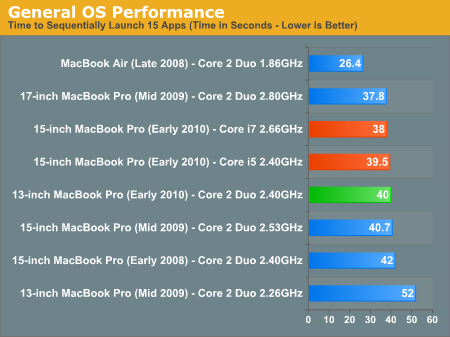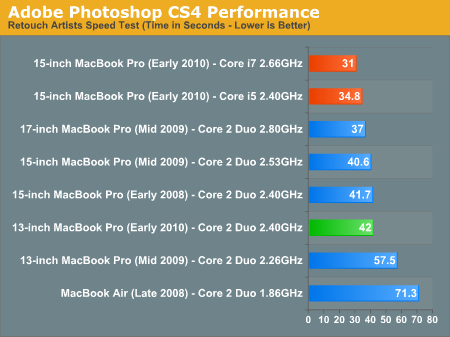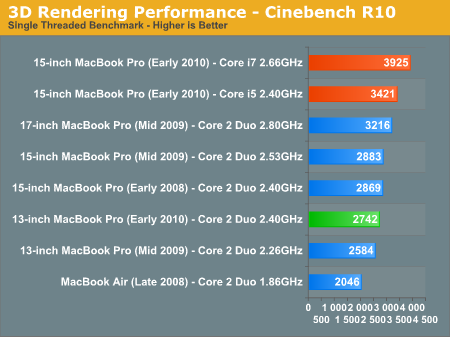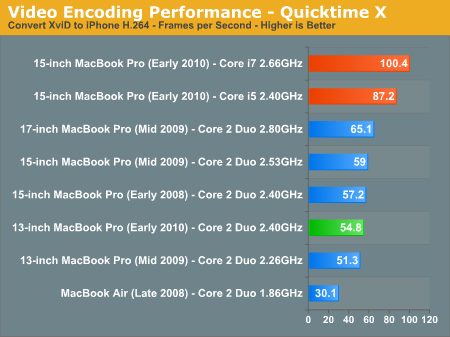Apple's 13-inch MacBook Pro (Early 2010) Reviewed: Shaking the CPU/GPU Balance
by Anand Lal Shimpi on June 9, 2010 12:15 AM EST- Posted in
- Mac
- Apple
- Intel
- MacBook Pro
- NVIDIA
General Performance: A Mild Improvement
We know what the GPU upgrade is good for, but what about the mild CPU bump in the 2010 13-inch MacBook Pro?
General OS usage is a difficult thing to quantify, but one measure of performance has always been the number of bounces an icon in the dock makes before an application loads. I decided to take it to the next level and write a quick script to launch 15 applications in a row, timing how long the entire process takes.
I launched, in order: Mail, Safari, Activity Monitor, iTunes, iCal, DVD Player, iPhoto, Photo Booth, Quicktime Player, Disk Utility, Preview, iMovie, Front Row, Garage Band and Aperture.
The entire process stresses both the disk and CPU, which is why we see a huge improvement when going to an SSD as well as differences between CPU speeds.

Application launch performance improves tremendously compared to last year's model thanks to the now standard 4GB of memory. The 2GB last year's model came with just wasn't enough. Now if you upgraded your previous gen 13-inch MBP then you'll hardly notice a performance improvement.
Also pay attention to just how well the Late 2008 MacBook Air does in this test. That's thanks to its SSD. Add an SSD to any of these notebooks and you'll see a similarly awesome increase in performance.
Adobe Photoshop CS4 Performance
The Retouch Artists Speed Test we use for our CPU testing under Windows also works under OS X. We're running the exact same benchmark here, basically performing a bunch of image manipulations and filters and timing the entire process.

Start doing real work with the 13-inch MacBook Pro and you'll note that it's significantly slower than the new 15-inch models. The Core i5 just rocks. Compared to last year's model the new MBP is much faster, but again that's due to the 4GB vs. 2GB of DDR3 that comes standard with the machine. An upgraded 2009 13-inch MBP would be basically the same speed.
Aperture 2 RAW Import
For my Aperture test I simply timed how long it took to import 203 12MP RAW images into the library.

Photographers and digital media creation professionals will want to opt for the 15-inch MacBook Pro, the faster CPU is definitely worth it.
Cinebench R10

In situations where we're not memory bound, the improvement over the previous generation 13-inch model is small. The performance improvement here is 6%. I'd say in most apps you'd see a 2 - 4% improvement over the 2.26GHz 13-inch from last year.

Quicktime H.264 Video Encoding
Our final benchmark is more consumer focused. Here I'm taking an XviD and converting it to an iPhone-supported H.264 format.

Encoding performance is improved over last year's 2GB/2.26GHz model, but no where near as much as the Core i5/i7 managed with the 15-inch model. If you're doing anything CPU intensive, the new 13-inch MacBook Pro isn't an upgrade.










93 Comments
View All Comments
jasperjones - Wednesday, June 9, 2010 - link
I find it highly inconsistent that AT doesn't test MBPs like any other laptops. Why do the charts compare the MBP to other MBPs instead of comparing it to laptops from Acer, ASUS, Lenovo, etc. that have been tested on this site?synaesthetic - Wednesday, June 9, 2010 - link
I assume because those laptops cannot (legally or for drivers/compatibility reasons) run OSX.DaveninCali - Wednesday, June 9, 2010 - link
Back on May 20th, I commented that the reason why we don't have discrete graphics for the 13" MB and MBP was because of space constraints. In response, I got this from Jarred Walton,"The "motherboard space" argument is absolute garbage."
http://www.anandtech.com/show/3733/apple-macbook-u...
How can an Anandtech staff member tell me my argument is complete garbage just 2 weeks before the editor-in-chief reviews the MBP saying that the reason we don't have discrete graphics is motherboard space? That doesn't make sense to me. Don't you guys talk to each other.
Of course, you can say that Apple can completely redesign everything but that doesn't make the reason why there is no discrete graphics because of space constraints any less valid. That's the reason given the current design.
So what will you give up if you redesign the motherboard for more space to accommodate discrete graphics? Smaller battery and therefore less battery life? 1.8" vs. 2.5" HDD therefore less disk space? Etc.
What say you Mr. Walton?
synaesthetic - Wednesday, June 9, 2010 - link
I enjoyed reading this review, Anand. Too often Apple product reviews are fanboy drool-fests that do little to point out the product's shortcomings. I, too, am very disappointed in Apple for making this new 13" MBP such an incremental upgrade.Yeah, the new IGP is "nice," but I've heard from people who have it that the 320M (also used in some HP laptops) is bunk and the Windows drivers are even *more* bunk. Lots of crashes, games refusing to run properly, etc. It's nice to see that in OSX, it runs quite well.
I'm a longtime PC user, and while I've been meaning to pick up an older 13" MacBook so I can learn OSX for professional reasons, I am hardly a fanboy of either. I do not like Steve Jobs, his attitude or his company, and I *do* think that Apple products are generally *a bad deal.*
I was pleasantly surprised with the massive upgrade they gave the iPhone 4 over the 3GS; I figured, due to the iPad's existence, that they would make the iPhone 4 a weak incremental upgrade. But instead they virtually invalidated the iPad's existence by tossing an A4 SoC and forward-facing camera into the new iPhone! (Here's hoping we get an iPod Touch 4, too, but I'm not holding my breath.)
What irritates me about Apple is that they are not cost-effective. You pay so much for so little computer. It makes me sad.
KoolAidMan1 - Thursday, June 10, 2010 - link
It depends on the machine. The majority of the 27" iMac's price is in the display. The same 27" display is $1100 from Dell, it'll be around $1500 from NEC. The 27" iMac starts at $1700. Given the performance, display quality, and all-in-one design, I'd hardly call it a bad deal.Similar thing with the notebooks given their extremely light weight without compromising battery life and performance. Then you have the best trackpad on the market with multitouch gestures (some of which even work in Windows via Boot Camp), the best keyboard outside of a Lenovo, the best international power adapter and airline seat adapters out there, and you can see why some people would want to drop a few extra dollars on them (or not even spend much more if we're comparing with a Sony or a business class Dell or HP).
osideplayer - Wednesday, June 9, 2010 - link
I am actually an avid PC user who was considering getting a MAC because of the new GPU's recently installed. I loaded a SSD with Ubuntu instead, but it's good to know I would have made a good decision. Considering I am graphics oriented and nobodies probably reading this anymore, so I guess im gonna go fart.vicbdn - Wednesday, June 9, 2010 - link
If Sony and Alienware can fit an i5/i7 and discrete graphics in the vaio Z and m11x, what is stopping Apple from doing that in the 13 in macbook? Sounds like B.S. to me.vicbdn - Wednesday, June 9, 2010 - link
Forgot m11x doesn't have a dvdrom drive...so nvm about that.overzealot - Wednesday, June 9, 2010 - link
You say that memory is entirely responsible for the faster load times/app performance.I think the increase in disk density (and, therefore sequential transfer rate) probably makes a decent impact as well.
evilpaul666 - Thursday, June 10, 2010 - link
Apple's strangely, poorly threaded iTunes is going to use OpenCL to transcode video in a future update.Wild speculation on my part, yes, but that's what its OpenCL everywhere push is all about.